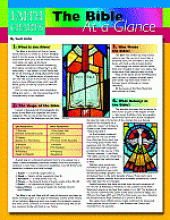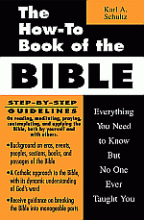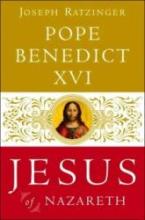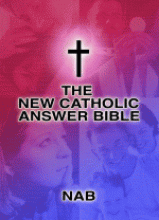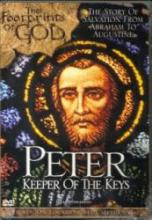Bible Study Helps
Faith Charts: The Bible at a Glance
Subject(s):
Grade / Age level:
Review:
When you study the Bible, do you find yourself confused by how what you're reading fits in with other parts of the Bible? Wouldn't it be nice to have an easy visual resource that helps you connect the pieces together and start to get a better sense of the whole?
This may be just what you're looking for. This colorful six-page laminated fold-out chart (written by Scott Hahn!) is a handy reference guide to have by your side when studying the Bible. It has brief, but helpful overviews on the following topics:
What is the Bible?
The Shape of the Bible?
Who Wrote the Bible?
What Belongs in the Bible?
The Bible and the Church
Interpreting the Bible
Your Reading Program
The Books of the Bible
Where to Find...
The last two sections constitute the bulk of this resource and, I believe, will be very helpful to many students of the Bible.
The "Books of the Bible" segment provides brief overviews of each book of the Old and New Testaments (including information on the Deuterocanonical books - those that have been left out of Protestant Bibles) and provides a helpful understanding of the major sections in both the Old and New Testament.
The "Where to Find..." section provides an easy to follow chart of major events from the Bible and what passage they can be found in. This section is divided into the following segments:
Old Testament:
Stories of the World's Beginning
Stories of the Patriarchs
Stories of Moses and the Exodus
Stories of the Conquest and the Judges
Stories of the United Kingdom
Stories of the Divided Kingdoms
Stories of the Exile and After
Prophecies of Christ
New Testament:
Jesus' Life - the Mysteries of the Rosary
Other Events in Jesus' Life
Jesus' Parables
The Birth of the Church
The Sacraments
The Bible in the Mass
Some Famous Sayings
I think it's particularly nice for busy homeschool moms to be able glance through this reference and find exactly what they're looking for. It also looks to be excellent for independent high school (and upper grade school) studies.
You don't have to look very many years back to find a time in which Catholics had to purchase Protestant materials in order to find such helpful, colorful Bible resources. This is happily no longer the case! Here, not only do you find relevant Biblical information, but also explanations of things like basic Catholic teaching on the relationship of Scripture and Tradition and where our Bible came from.
This chart also goes nicely with Scott Hahn's little Pocket Guide to the Bible (79 pgs, approximately 4x6 in.) which includes a great deal of the content found on this resource, but with more extensive explanations and less in the way of charts and overviews.
Perspective:
Catholic
Reviewed by:
First reviewed:
10-19-2008
How-to Book of the Bible
Subject(s):
Grade / Age level:
Review:
I was pleasantly surprised when I sat down with this book—actually, I was hooked! And another thing: I wish this book was available during my years of Bible study.... If you think the subtitle—Everything You Need To Know But No One Ever Taught You—is a little pretentious, it isn't. This book really does live up to its claim: it answers all of those questions you may have had about the Bible. Which translation is best? Why? Protestant Vs. Catholic Bible? And what about the Old Testament? How to understand puzzling passages? And more, much more. If you are a curious person and are always willing to learn something new, chances are you will love this approach to understanding and tackling the Bible. Furthermore, even if you have participated in Bible study for many years, I believe you will find something in this friendly volume that you didn’t know before!
The book is divided into three sections following an explanatory introduction, presenting to the reader the way the book works. It is in the introduction for instance that the first question appears: Why read the Bible? A solid argument for the importance of the most influential book of Western Culture follows, along with spiritual reasons. Here we also become familiar with the format of the book and icons used throughout, along with several considerations to be made.
The three sections are entitled "How to read the Bible", "How to read the New Testament", and "How to read the Old testament". Each section contains from six to eleven chapters. It would be smart to read the book in the order presented, but it is also possible to fully enjoy it by just picking it up and reading a page chosen at random. There is a useful bibliography of sources, but I would have liked to see an index. It would have been more useful to those using this book as an aid to a Bible study. Yet, the book is so well and clearly sectioned that the table of contents should serve a similar function.
Editorial Review: Perhaps you know very little about the Bible … or enough to realize there’s so much more to discover! Maybe your previous attempts to read the Bible have not been fruitful, and you don’t get much out of the readings at Mass. You observe the role the Bible plays in the lives of others and feel that you’re missing something. The How-To Book of the Bible, by Karl A. Schultz, is your key to unlocking this treasure. Unlike other Bible-related books, this one not only introduces you to the Scriptures but also helps you develop a deep, fulfilling, and lasting bond with the Bible. I believe this would make a fantastic choice for a high school homeschool student who needs a year of Bible. The format and language will appeal to the young student and in comparison with the dryness of the texts available to homeschoolers, this will shine. I would love to see a workbook companion for this, complete with tests and an answer key!
Perspective:
Catholic
Reviewed by:
First reviewed:
9-17-2006
Jesus of Nazareth
From the Baptism in the Jordan to the Transfiguration
Subject(s):
Grade / Age level:
Resource Type:
Review:
It's rather lovely, I think that the Pope uses in his own book a phrase (which he applies to the parables of Jesus) which aptly describes this fascinating book: "...it not only or even primarily adds to what we know, but it changes our lives."
In Jesus of Nazareth, Our Holy Father presents a vision of primary events of the Gospels (this volume covers significant stories chronologically from the Baptism of Our Lord through the Transfiguration - a second volume is expected in the future). He delves into these Gospel stories (many of which are commonly taken for granted - both because we've heard these stories since we were young and because we're missing some of the background details that add depth and additional significance to these stories) to help bring Our Lord to life for modern readers.
Here are the basic Gospel stories that are covered in the text:
The Baptism of Jesus
The Temptations of Jesus
The Kingdom of God
The Sermon on the Mount
The Lord's Prayer
The Disciples
The Parables (with an emphasis on The Good Samaritan, The Prodigal Sun and the Rich Man and Lazarus)
Images from St. John's Gospel (Water, Vine and Wine, Bread, and the Shepherd)
Peter's Confession
The Transfiguration
Jesus Declares His Identity (The Son of Man, The Son, "I Am")
Here's a sampling of the style and content of the book, taken from the chapter on the Our Father in which the Pope discusses what we mean by "Hallowed be Thy Name".
God establishes a relationship between himself and us. He puts himself within reach of our invocation. He enters into relationship with us and enables us to be in relationship with him. Yet this means that in some sense he hands himself over to our human world. He has made himself accessible and, therefore, vulnerable as well. He assumes the risk of relationship, of communion, with us. The process that was brought to completion in the Incarnation had begun with the giving of the divine name.... God has now truly made himself accessible in his incarnate Son. He has become a part of our world: he has, as it were, put himself into our hands. This enables us to understand what the petition for the sanctification of the divine name means. The name of God can now be misused and so God himself can be sullied. The name of God can be co-opted for our purposes and so the image of God can also be distorted. The more he gives himself into our hands, the more we can obscure his light; the closer he is, the more our misuse can disfigure him. Martin Buber once said that when we consider all the ways in which God's name has been so shamefully misused, we almost despair of uttering it ourselves. But to keep it silent would be an outright refusal of the love with which God comes to us. Buber says that our only recourse is to try as reverently as possible to pick up and purify the polluted fragments of the divine name. But there is no way we can do that alone. All we can do is plead with him not to allow the light of his name to be destroyed in the world.He elucidates the various Gospel stories from many angles, though certain patterns emerge. In many places, he discusses and refutes modern theories about the Life of Christ (many of which have the common thread of doubting the historical validity of the Gospels). These are usually the most difficult portions of the book to follow. I found it helpful to underline principal portions in order to keep a particular thread fresh in my memory. Brief notes on the various threads might also be helpful. He also references Eastern imagery from traditional icons and what we have learned from Tradition (from the teachings of the Church Fathers) about the various Gospel passages. This is a life-changing book. There are many stories, like the Transfiguration, that I had little understanding of to begin with and will never hear or think about in the same way again. I studied this over the course of a school year with a group of high school students. We studied approximately 10 to 15 pages at a time and discussed everything in depth. I don't think it's a book that most high schoolers could read on their own. Reading it in chunks together allowed us to delve into it more deeply (I'm certain that I got more out of it than I would have if I had read it on my own.) The discussions provided an opportunity to clarify confusing parts of the text (many times I was able to provide some helpful background info such as an explanation of a philosophical idea). The students really enjoyed the book and got a lot out of it. Besides the obvious benefits of the content of the book itself, they're now less intimidated by an "intellectual" book and understand that it's okay to just make a beginning in reading such a book and that it's perfectly normal to get more out of such a book every time they read it. For those who might be interested, I wrote a number of blog posts on this book while I was studying it. You can read them here.
Perspective:
Catholic
Additional notes:
Recently released in softcover by Ignatius Press (that edition includes an index!). They are also expected to release a study guide for this book in October 2008.
An audio version is also available through your local bookstore or from Audible.com
Reviewed by:
First reviewed:
10-8-2008
The New Catholic Answer Bible
Subject(s):
Review:
The New Catholic Answer Bible is a pretty standard revised New American Bible (RNAB) plus inserts about various aspects of Catholic teaching. It is not (as I had at first thought) a "study Bible" with lots of notes about the Scriptural content, relating it to doctrine, liturgy, history, etc. The inserts are basically short apologetic tracts written by a pair of well-known Catholic apologists. A reference to the book of the Bible into which they are inserted often, though not always, provides a connection.
The inserts take the form of a question about the Faith and its corresponding answer. A box at the bottom of the page provides a quick reference to the texts cited as well as additional Scripture and Catechism references. Each insert is limited to a single page, so they are necessarily brief in their treatment of the topic. Nevertheless, they do provide a good basic understanding of the answer and a starting point for further inquiry using the information in the box at the end.
A sampling of the topics addressed:
- What is Apologetics?
- Does the Church Teach Evolution?
- Why is Catholic Worship Full of Rituals?
- What is the Holy Trinity?
- Aren't Statues a Form of Idolatry?
- Why Won't the Church Ordain Women?
- Why Are Abortion and Embryonic Stem Cell Research Wrong?
At the same time, no matter how terrible the evil caused by sin, God is great enough, and wise enough, to bring about through that evil an even greater good (see Gn 50:20, Rom 8:28).The first reference is what Joseph says to his brothers when they come to Egypt to get grain, while the second is the famous "All things work out for good for those who love God." Although these references do speak of God bringing good out of evil, it was not obvious to me that it was an "even greater good" than the one God would have brought about had the evil not taken place. In another place, insert K-3 (about divorce) refers to Mt. 19:9, which contains the (in)famous "exceptive clause." Unfortunately, the RNAB has a unique rendering of this exception as "unless the marriage is unlawful," which is an interpretation or commentary; the actual text literally reads "except for unchastity." I am uncomfortable with the tract treating this gloss as though it were really what the Bible says. It may work with someone who only uses this Bible version, but what happens when he encounters a different version, or a Protestant calls him on it? I consider these quibbles and overall, Thigpen and Armstrong have done an excellent job of explaining the Church's teaching on a variety of topics simply and accurately.
Although I very much liked the inserts, the actual Bible translation, unfortunately, has significant problems -- as explained here.
Perspective:
Catholic
Additional notes:
This book includes RNAB Bible text and reference aids, plus 88 pages of inserts for a total of 2008 pages.
Reviewed by:
First reviewed:
4-17-2008
Peter: Keeper of the Keys
Setting:
Grade / Age level:
Resource Type:
Review:
This is a fascinating travel/apologetics documentary focusing on the story of Saint Peter as related in the New Testament. Apologist Steve Ray travels to Rome and many sites in the Holy Land to tell Peter's story. He provides fascinating details of the connections between particular places and important events in Peter's life.
This would make a great supplement to a Bible study, an apologetics lesson on the Papacy, a geography unit on the Middle East or simply an important part of Church history. Our teen discussion group watched this together just after reading the chapter in Pope Benedict's Jesus of Nazareth on Peter's Confession and the story of the Transfiguration. The DVD tied into these themes very nicely.
We very much enjoyed the professional quality of this video that is packed with theological and geographical insights, connections with Old Testament History and a nice visual perspective to well-known Bible stories. The format is engaging and the visuals help make the particulars of the story quite memorable.
I would suggest that this is best for high school and adult viewers, but some younger viewers might enjoy it after a parental preview.
Reviewed by:
First reviewed:
4-17-2008

